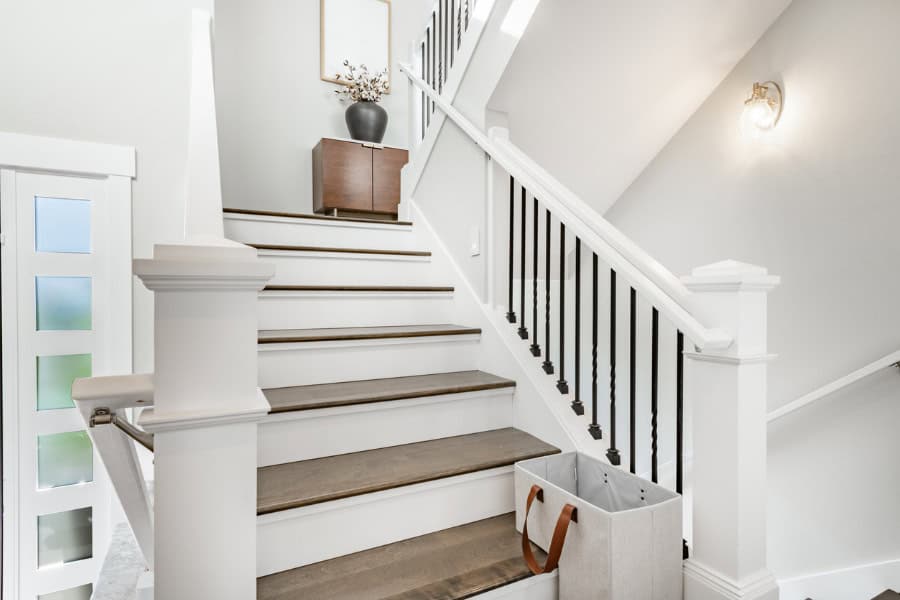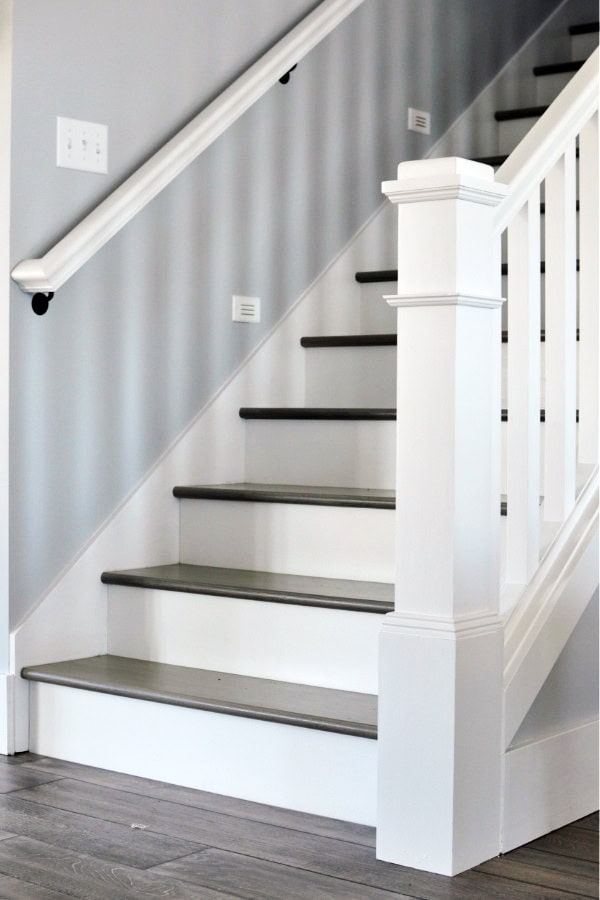Let’s be honest, carpeted stairs have had their moment.
They’re soft and cozy, sure, but they also trap dirt, wear down fast, and start to look tired before you know it.

If you’ve ever pulled up old carpet from stairs, you know exactly what I mean.
Underneath all that fuzz, there’s usually a pretty decent set of steps just waiting for a second chance.
So if you’re ready to ditch the carpet and give your staircase a fresh new look, I’ve got some great alternatives that can totally change the feel of your home.
I’ve seen all kinds of creative stair makeovers over the years.
Some simple. Some bold.
And the best part is, there’s no one “right” way to do it.
Let’s walk through a few options that fit different styles, budgets, and skill levels.
Hardwood Stair Treads for a Timeless, Polished Look
Hardwood stairs are a classic for a reason.
They instantly make a home feel more open and polished.
If you’ve got wood floors already, matching your stairs to them creates a smooth, cohesive flow from one level to the next.
I’ve used oak, maple, and hickory on projects, and they all hold up beautifully.
You can stain them to match your floors or go darker for contrast.
It’s amazing how much personality that small choice can add.
Now, hardwood can be slippery, especially if you’ve got kids or pets racing up and down.
Adding a runner or anti-slip pads is a smart move.
And it can look great too.
There’s something about wood stairs that just feels solid and timeless.
They’re built to last.
Below are four of the most popular hardwood options for stairs and what to know about each before choosing one.
Oak Stairs: Durable and Classic
Oak is hands down the most common choice for hardwood stairs.
It’s strong, long-lasting, and takes stain evenly, which makes it easy to match with other wood tones in your home.
Red oak has a warm, slightly reddish hue that works well in traditional spaces, while white oak has a more neutral tone that fits modern or minimalist homes.
Oak resists dents and scratches better than many other woods, which is great if your stairs see heavy foot traffic.
It’s also readily available, so prices tend to be more reasonable compared to exotic woods.
The grain pattern is fairly prominent, which gives oak stairs a natural, textured look that hides wear nicely over time.
Maple Stairs: Smooth and Contemporary
Maple is a great choice if you want a clean, modern look.
It has a fine, smooth grain and a lighter color that brightens up stairwells and hallways.
Because it’s dense and hard, it holds up well to daily use, though it can be a little tricky to stain evenly.
If you like lighter, natural finishes, maple looks beautiful with just a clear sealer.
It’s a good pick for homes that lean toward Scandinavian, modern, or transitional styles.
One thing to note is that maple can show scratches a bit more easily than oak, so if you have pets, you might want to go with a matte finish to help disguise wear.
Hickory Stairs: Rustic and Tough
Hickory is one of the hardest domestic hardwoods you can use on stairs.
It’s incredibly durable, which makes it ideal for busy households or high-traffic areas.
The color variation in hickory is part of its charm. Light and dark streaks blend together to create a rustic, natural look that stands out.
If you like a bit of character and don’t mind some variation from step to step, hickory is a winner.
It pairs beautifully with farmhouse, rustic, or industrial interiors.
Because it’s so hard, it can be a bit tougher to cut and install, so this is one where a professional installer might be worth the cost.
Walnut Stairs: Rich and Sophisticated
Walnut brings a deep, elegant tone that instantly adds warmth and luxury to a space.
It’s not as hard as oak or hickory, but it’s still strong enough for residential stairs.
The rich brown color and subtle grain make it perfect for more formal or high-end interiors.
Walnut’s natural beauty really shines with a clear finish rather than a heavy stain.
It does tend to be more expensive than other hardwoods, and because it’s a bit softer, you’ll want to be mindful of shoes or sharp objects that could cause dents.
Still, if you’re after a staircase that feels refined and timeless, walnut is hard to beat.
Each of these hardwoods offers its own unique look and benefits.
Whether you go with the classic appeal of oak, the clean simplicity of maple, the rugged texture of hickory, or the rich tones of walnut, hardwood stairs can completely transform how your home feels.
They’re an investment, but one that pays off in both style and durability for years to come.
Laminate or Vinyl Planks Offer Style on a Budget
If you want that wood look without the higher price tag, laminate or luxury vinyl planks are worth considering.
I’ve done a few staircases with vinyl planks that even fooled me at first glance.
They look THAT realistic!
These come in tons of finishes, from rustic oak to sleek gray tones, and they’re tough enough for daily wear.
Vinyl is especially good if your stairs are near an entryway or basement where moisture might be a problem.
It’s easy to clean and doesn’t scratch easily. Installation is pretty straightforward too.
Those click-lock systems make life easier. Just don’t skip the stair nosing pieces.
They give the edges a clean, finished look and help prevent tripping.
Painted Stairs Bring a Fun, Custom Touch
If you’re working with a tighter budget or want to have some fun, painted stairs can look surprisingly stylish.
I’ve seen homeowners go with crisp white risers and dark treads for a traditional look.
Others go bold with color for something more modern.
Heck, you could even paint each riser a different shade of blue for a beachy-coastal vibe.
My personal favorite is using Sherwin-Williams Iron Ore on stairs.
Iron Ore is a great choice for wooden stairs because it brings visual weight and drama while remaining neutral and versatile!
It supports contrast with natural wood, conceals wear, and suits many styles.
The key is to use a durable floor paint and mix in a non-slip additive. That way, your stairs stay safe and look good.
Painted stairs will show wear over time, but touch-ups are quick and easy.
It’s the kind of project you can knock out over a weekend and feel proud of every time you walk upstairs.
Tile Stair Risers Add Texture and Personality
If you like patterns or textural elements in your home, tile stairs can really make a statement.
Even just tiling the risers adds a ton of visual interest without going overboard.
We’ve all seen homes with colorful Moroccan-style tiles on the risers with simple wood treads.
You know how this completely transforms the space.
Porcelain and ceramic tiles are durable and easy to clean, though they can get slippery if you tile the treads too. Textured tiles or stair nosing help with that.
Tile takes patience to install, but once it’s done, it’s practically maintenance-free. And it looks incredible.
And to avoid installation hassle and cost, you can even opt for stair riser stickers that look pretty darn good!
Concrete or Microcement Finish Delivers a Modern, Sleek Vibe
For a modern, industrial vibe, concrete or microcement stairs have that cool, understated look that’s hard to beat.
They’re sleek, durable, and surprisingly versatile.
Microcement can even be applied over existing stairs, giving you a smooth, continuous finish that feels custom-built.
I’ve seen this look paired with black metal railings or warm wood accents. It balances out beautifully.
It’s not the easiest DIY project though. You’ll want a pro for this one to get that seamless finish.
But once it’s done, you’ll have stairs that look straight out of a design magazine.
Natural Wood with a Clear Sealer Highlights Warmth and Character
Sometimes the best thing you can do is just let the wood speak for itself.
If your stairs are already wood, sanding them down and sealing them can bring out all that natural character.
I love this approach in older homes where the wood has some history.
Little dents and imperfections just add charm.
A clear polyurethane or oil finish will protect the surface and make it easy to clean.
It’s simple, warm, and feels authentic. And it never goes out of style.
Just make sure to tighten any loose boards or fix squeaks before you start.
Once you’ve got smooth, quiet stairs, you’ll wonder why you didn’t do it sooner!
FAQ: Choosing the Right Stair Covering for Your Home

What’s the most durable option for stairs without carpet?
Hardwood and tile are both top performers for durability.
Vinyl planks are a close second if you want something tough but still budget-friendly.
Which option is safest?
Vinyl and laminate with textured finishes are great for traction.
You can also add anti-slip treads or a narrow runner on wood stairs for extra grip.
Can I handle this project myself?
Painting, vinyl, and laminate are all pretty DIY-friendly.
If you’re handy and patient, you can get a great result.
Tile, hardwood, and concrete finishes take more skill, so those are better for professionals.
What’s the most affordable way to cover stairs?
Paint wins for affordability.
Laminate or vinyl are the next step up in price but still very reasonable.
How do I match my stairs to my home’s style?
For modern homes, concrete or sleek vinyl looks great.
Traditional homes pair well with hardwood or painted stairs.
If your home leans rustic or eclectic, natural wood or patterned tile can add warmth and personality.
No matter which route you choose, covering your stairs without carpet is one of those projects that instantly makes your home feel fresher and more personal.
It’s a chance to show off your style, improve durability, and say goodbye to vacuuming those dusty steps forever.
Whether you go sleek and modern or warm and classic, you’ll end up with stairs that you actually enjoy walking on.
And that’s a win in my book.
